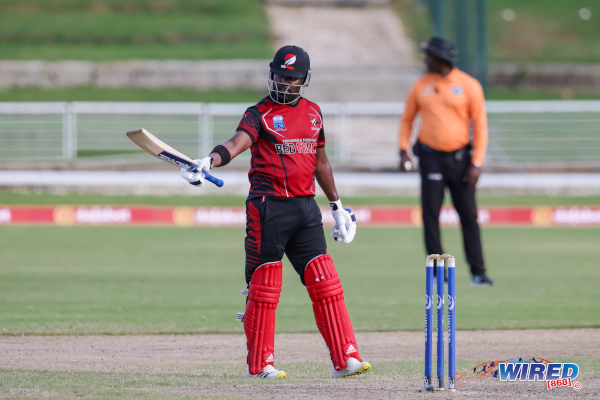As a West Indian, I consider it my duty to promote the second most popular sport in the world wherever I happen to be. After all, cricket is what makes life bearable in all kinds of circumstances. That is why I have become not only the official scorer for Cricket Peru, but a member of the Committee as Women’s Cricket Officer as well.
In Peru, while the 150-year-old Lima Cricket and Football Club (LCFC) is located in Magdalena del Mar, a coastal district of Lima, cricket there has been played mainly by resident expatriates.

(Courtesy Steve Hallett)
In recent years the Asociación Peruana de Cricket (Cricket Peru, or CP) has introduced coaching in several of the International schools here in Lima. In an effort to develop the sport even further at the grass-roots level the Association approached Mayor of Magdalena del Mar, Francis Allison, with a proposal to make the district the first in Peru to develop a full scale cricket coaching programme.
The first step was to attract interest in a game which, though the second most popular in the world, is almost unknown in Peru. What better way to explain than to demonstrate?
With the support of the Mayor and excellent coordination by the Municipality’s liaison person Carmen Kuong (whose official title of Deputy Manager of Disaster Risk Management was not initially very encouraging), it was agreed that Cricket Peru would hold three “Mass Participation Events” for young people in the local community.
The municipality agreed to provide the young people and the venue and Cricket Peru put together a series of cricket-related activities and a barbeque. Participants would then be given the option of signing up for a weekly Cricket Academy—all at no cost.
The first of these events was held On Saturday 8 November at the sensuously named Coliseo Chamochumbi, a municipality-managed football stadium in Magdalena. It was a great success with up to 80 young people—mainly between the ages of 7 and 17—getting a taste of the game.

(Courtesy Juliet Solomon)
Cricket Peru volunteers manned activity stations set up around the football pitch where groups took turns practicing fielding, catching, throwing at the stumps, batting and bowling.
Harry Hildebrand, famous raconteur, master sledger and President of Cricket Peru, opened the proceedings. Declaring his Peruvian citizenship by waving his document de identidad (DNI), he proceeded in ‘Auzzie-accented Spanish’ to suggest that while Peruvians are devoted to football they had not in living memory made it to the World Cup so “why not give it a rest and try a new sport”.
This auspicious opening was followed by a swift demonstration game played at one end of the football pitch by CP volunteers while Harry explained the action blow by blow.
It looked to be shaping up into an uphill struggle when the first ball was bowled. A slow delivery, the batsman offered no shot and the ball trickled past the wicket keeper. The stumps having been set up directly on the goal line, a cheer went up from the attentive spectators as the ball came to rest at the back of the net.
“Gooooooooaaaal!!!”
At first, once we got the kids on the pitch, things did not get much better. They quickly grasped the concept of throwing the ball at the stumps when made to stand in a line and throw directly at them. However, once we moved on to a tip-and-run game all hell broke loose.

(Courtesy Steve Hallett)
The concept of two batsmen running past each other and only one of them allowed to hit the ball at a time seemed to defeat them. As soon as the facing batsman hit the ball, instead of running towards the opposite stumps the non-facing batsman would chase after the ball and try to hit it as well.
A couple of the non-facers even tried to hit the ball as it left the bowler’s hand—seeming to think that it was some kind of free-floating piñata. It took multiple attempts and screams of “corre! corre!” accompanied by hard shoves between the shoulder blades to get the idea across.
However, this led to more complications. The fielders, also weaned on the concept of chasing a football with single-minded intensity, could not get it through their heads that they had to wait until after the batsman hits the ball to chase after it. Attempts to bowl at the facing batsman were constantly interrupted by three or four small lads leaping Gus Logie-like from point or cover to snatch the ball out of the air before the batsman could offer a shot.
When the batsman did manage to hit the ball, the entire crew: off and on-side fielders, wicketkeeper, bowler, non-facing batsman—the lot—would hare after the ball and end up in a heap on the ground trying to wrestle it from each other.
In addition, getting the fielders to keep the wicket clear so that the batsmen could cross unhindered fell on deaf ears. It was the ball that mattered. Everybody was totally focused on the ball. Chase it!!! One you get it, keep it. Forget what you learned about throwing it back to the wicketkeeper or knocking off the bails.

Young participants chase the ball in the outfield with relish.
(Courtesy Juliet Solomon)
But eventually things settled down and the real fun started. Now everyone wanted to bat. One young lad found a batting helmet among our kit and faced off with great pride against the plastic ball thrown gently underarm.
A group of scruffy kids wandered in off the street, two girls, a boy and a toddler. They were clearly not members of the sports club teams that we were training. They stared in fascination for some time until the younger girl summoned her courage and edged up to me. “Señora…es gratis?”
I replied that of course it was free and eventually Lucero, Fiorella, Aron and even baby Angie were persuaded onto the pitch and joined in with great enthusiasm.
We met a 15-year-old local athlete who had discovered cricket somewhere or the other (ESPN maybe) and had been looking for the means to play it for the last three years.
Several of the parents and even unattached local adults sat in the stands watching the proceedings. When we started distributing flyers explaining the game they were eagerly received.
We then walked around with sign-up sheets and, having been reassured that it would cost nothing, we managed to recruit a health number of attendees for the Cricket Academy which CP will be running every Monday evening for now on.

(Courtesy Juliet Solomon)
Next year Peru will host the South American Under 13 and Under 17 Championships. If all goes well, we expect certain Magdalena residents to represent their country in their new favourite sport.
Who knows, perhaps in the near future a tour of the West Indies?
(If the WIBC doesn’t mess it up).
Juliet Solomon is a globtrotting Trinidadian who now lives and writes in Peru. She is the official scorer and Cricket Women`s Officer for Cricket Peru (http://perucricket.com/) and an active member of the Good Companions Theatre Group.
Her book about her experiences in Lima, “Yes…But It´s Different Here” is available on Amazon.com.
 Wired868 Wired868 for smart sport news and opinion
Wired868 Wired868 for smart sport news and opinion







Enjoyed the tale…. I pictured the frustration but the funny side was hilarious throughout. Thanks Juliet.
delightful, Juliet!
I’d like to see some of those “early days” score-sheets. Especially the methods of dismissal.
And Juliet has form for selling the Caribbean in Peru: http://wired868.com/2013/05/09/a-drop-of-tt-makes-the-pisco-sour-go-down/
it was quite funny picturing it
Sounds like a lot of fun too. Vividly told. Well done, Juliet Solomon 🙂
“Why not give it (football) a rest and try a new sport”. Lol that was harsh
Really funny tale of introducing a new sport to kids. It will be interesting to follow their progress.
I don’t know how to say it in Spanish but that, dear Juliet, (meaning in your last line) is where the shoe pinches.